Sigma 12-24mm F4 DG HSM Art Review

Introduction
The Sigma 12-24mm F4 DG HSM Art is a new ultra-wide-angle zoom lens for full-frame and APS-C DSLR cameras. It offers the equivalent angle of view as an 18-36 mm lens on an APS-C system (depending on the crop factor). The Sigma 12-24mm F4 DG HSM Art has 16 elements in 11 groups and the largest aspherical glass mold (80mm diameter) in the industry and it features a rounded 9 blade diaphragm which creates an attractive blur to the out of focus areas of the image. It has a minimum focusing distance of 24cm / 9.4in and a maximum reproduction ratio of 1:4.9, silent high-speed AF performance, full-time manual focusing, dust- and splash-proof construction and Sigma's Super Multi-Layer Coating to reduce flare and ghosting. The Sigma 12-24mm F4 DG HSM Art lens retails for £1649.99 / $1599 in the UK and the US, respectively.
Ease of Use
Weighing in at 1150g and measuring 13cms in length, the Sigma 12-24mm F4 DG HSM Art is a very big lens indeed, almost identical to the Canon EF 11-24mm f/4L USM. While you can use it on a smaller APS-C body for an 18-36mm equivalent angle of view, it won't balance very well at all. As demonstrated by the images below, it's a much better match for a professional-grade, full-frame camera like the Canon EOS 5DS R, and even then you'd probably want to fit a battery grip when using it hand-held.
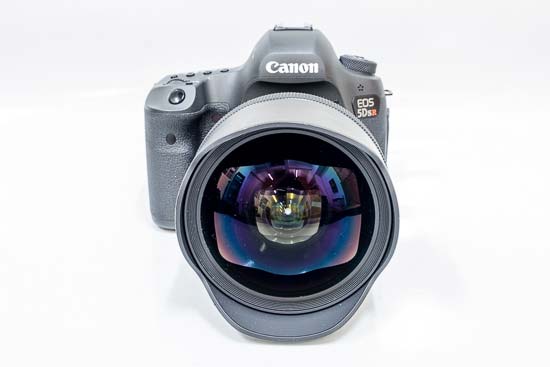 The Sigma 12-24mm F4 DG HSM Art lens mounted on a Canon EOS 5DS R
The Sigma 12-24mm F4 DG HSM Art lens mounted on a Canon EOS 5DS R
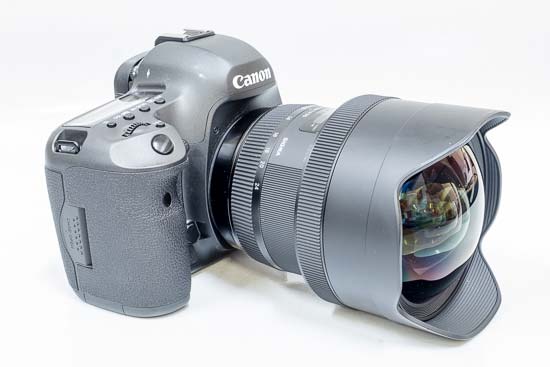 The Sigma 12-24mm F4 DG HSM Art lens mounted on a Canon EOS 5DS R
The Sigma 12-24mm F4 DG HSM Art lens mounted on a Canon EOS 5DS R
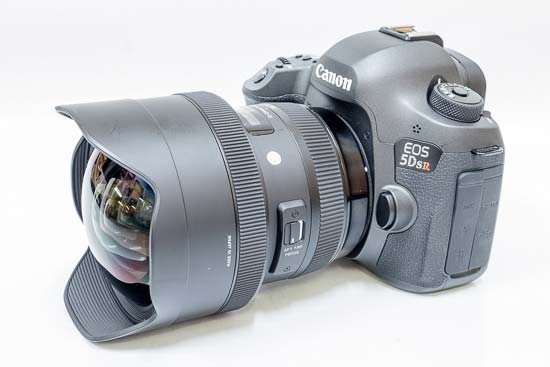 The Sigma 12-24mm F4 DG HSM Art lens mounted on a Canon EOS 5DS R
The Sigma 12-24mm F4 DG HSM Art lens mounted on a Canon EOS 5DS R
 The Sigma 12-24mm F4 DG HSM Art lens alongside a Canon EOS 5DS R
The Sigma 12-24mm F4 DG HSM Art lens alongside a Canon EOS 5DS R
Build quality is excellent. The lens has a plastic shell with a mixture of metallic parts and a new compound material, TSC (Thermally Stable Composite), used inside. It also incorporates a brass bayonet mount that's supposed to be more durable. The optical elements are made of high-grade glass. The focus ring is rather narrow, although it is at least ridged for easier grip. The lens also features a distance scale.
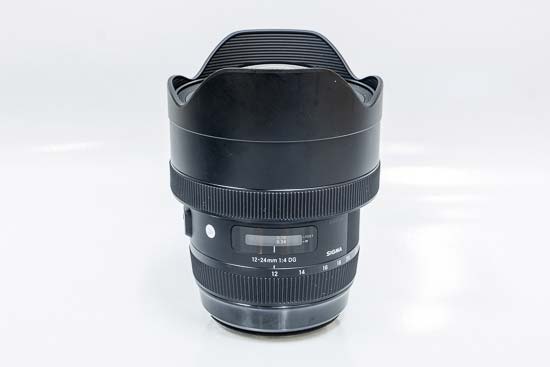 Side of the Sigma 12-24mm F4 DG HSM Art lens
Side of the Sigma 12-24mm F4 DG HSM Art lens
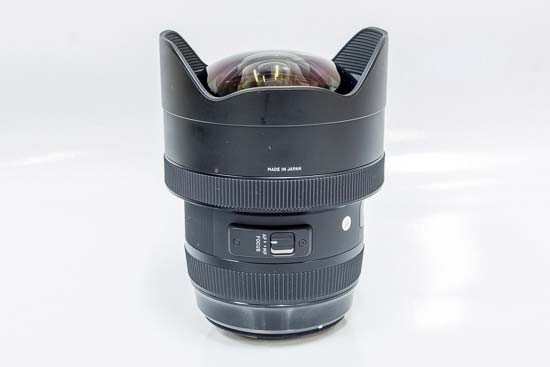 Side of the Sigma 12-24mm F4 DG HSM Art lens
Side of the Sigma 12-24mm F4 DG HSM Art lens
In terms of features, the Sigma 12-24mm F4 DG HSM Art offers all the basics that you need, and it's usefully weather-sealed too thanks to its dust- and splash-proof construction. The main exception is the lack of built-in Vibration Reduction.
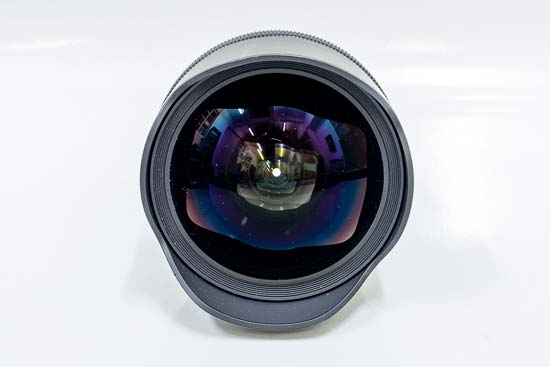 Front of the Sigma 12-24mm F4 DG HSM Art lens
Front of the Sigma 12-24mm F4 DG HSM Art lens
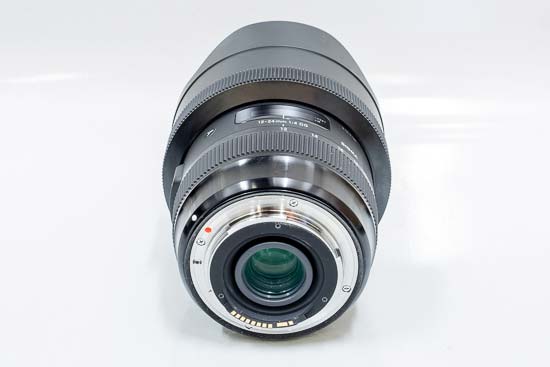 Rear of the Sigma 12-24mm F4 DG HSM Art lens
Rear of the Sigma 12-24mm F4 DG HSM Art lens
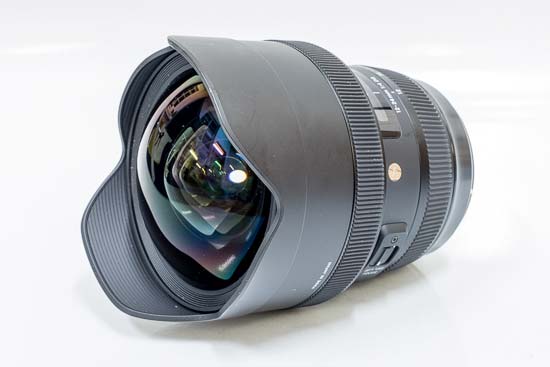 Front of the Sigma 12-24mm F4 DG HSM Art lens
Front of the Sigma 12-24mm F4 DG HSM Art lens
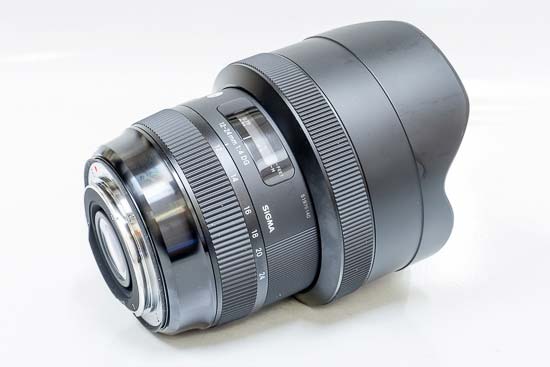 Rear of the Sigma 12-24mm F4 DG HSM Art lens
Rear of the Sigma 12-24mm F4 DG HSM Art lens
Focusing is usefully internal and manual focusing is possible when set via the Focus switch on the lens barrel. Full-time manual focus override is also available at any time simply by rotating the focus ring. A clear distance scale in both feet and meters runs from the closest focusing distance of 0.24m / 0.79 ft to infinity.
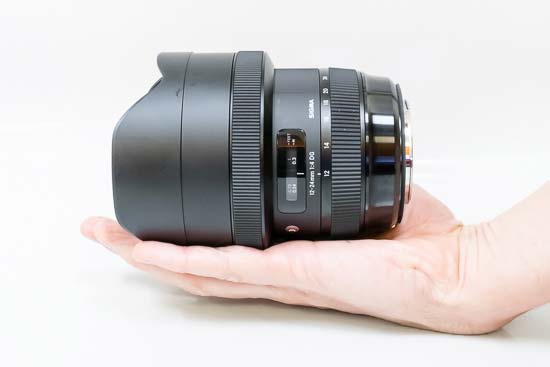 The Sigma 12-24mm F4 DG HSM Art lens in-hand
The Sigma 12-24mm F4 DG HSM Art lens in-hand
The Sigma 12-24mm F4 DG HSM Art ships with a good quality soft case, a fixed plastic petal-shaped lens hood and a large round lens cap. Given the cost of the lens, we'd have liked to have seen a hard case included. Note that this lens doesn't accept standard screw-on circular filters due to its large, bulbous front element.
Focal Range
At the 12mm focal length the angle of view is 122 degrees, and at the 24mm focal length it's 84.1 degrees.
 Field of view at 12mm
Field of view at 12mm
 Field of view at 24mm
Field of view at 24mm
Focusing
The Sigma 12-24mm F4 DG HSM Art lens has a rather narrow focus ring. There are hard stops at both ends of the range, though, making it easier to set focus at infinity.
When it comes to auto-focusing, the Sigma 12-24mm F4 DG HSM Art zoom is a quick performer, taking about 0.15 seconds to lock onto the subject when mounted on the Canon EOS 5DS R that we tested it with.
We didn't experience much "hunting", either in good or bad light, with the lens accurately focusing almost all of the time. It's also a very quiet performer, thanks to the built-in HSM (Hyper Sonic Motor), which makes this lens well-suited to video recording.
Chromatic Aberrations
Chromatic aberrations, typically seen as purple or blue fringes along contrasty edges, is quite well-controlled but can be detected in some shots, as shown below.
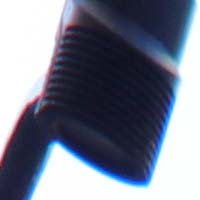 |
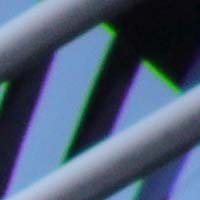 |
Light Fall-off
With the lens set to its maximum aperture of f/4, there is some light fall-off in the corners. Stopping-down to f/8 virtually eliminates this.
 Light fall-off at 12mm
Light fall-off at 12mm
 Light fall-off at 24mm
Light fall-off at 24mm
Macro
The Sigma 12-24mm F4 DG HSM Art isn't claimed to be a macro lens, with a minimum focusing distance of 24cm / 9.4in. and a maximum magnification ratio of 1:4.9. The following example demonstrates how close you can get to your subject.
 Close-up performance
Close-up performance
Bokeh
Bokeh is a word used for the out-of-focus areas of a photograph, and is usually described in qualitative terms, such as smooth / creamy / harsh etc. In the Sigma 12-24mm F4 DG HSM Art lens, Sigma have employed an iris diaphragm with nine rounded blades, which has resulted in nice bokeh in our view. We do realise, however, that bokeh evaluation is subjective, so we've included several 100% crops for your perusal.
 |
 |
Sharpness
In order to show you how sharp this lens is, we are providing 100% crops on the following pages.
